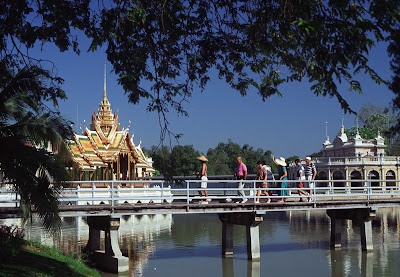Ayutthaya: Bygone Glory
Ayutthaya’s heydays in the 17th Century saw it
become the most fabulous city in the Orient, a centre of pomp and glory, with
fabulous temples built by its people in honour of their Gods, and palaces for
their royalty. The buildings were constructed on a grand scale, set amidst landscaped
gardens, and given definite shapes, all of which testify to a well-developed
architectural flair. Today, restored ruins tell the story of those bygone days
of glory.
Today, visitors find a rare sense of space here that’s
soothing both to the mind and body, and the effect of the overall vastness is
enhanced by the comparative lack of vehicular traffic and complete silence.
Replete with attractions, a city tour is as educative as
it’s interesting. The restored ruins still show their rough, rugged beauty
through elegant shapes and distinct contours. Shells of palaces lie in the
middle of large courtyards, precariously leaning pagodas partly submerged
beneath vegetation, stop one’s walk around the city. There are countless,
diverse smaller structures, and a superb and priceless collection of Buddha
images, some neatly lined up in a row as though part of some grand ceremony. In
keeping with their religious and heritage value, the Buddha images deserve
respect. It’s considered disrespectful to point one’s feet towards them or
ascend to higher levels than where they are placed. And smoking is prohibited.
Some landmark sites are the ruins of the former royal
palace, once a complex of several buildings, something like a ‘city within a
city’. And the Chao Sam Phraya National
Museum that’s stocked with old
handicrafts and Thai art treasures that span several centuries of
craftsmanship. Amidst these treasures, is a relic of great value - a large
Buddha image called the Phra Mongkhon Bophit.
A fairytale scene of architectural wonders awaits one at
Bang Pa-In Summer Palace, which played a significant role in former royal days.
Featured is a unique collection of ornate ceilings, pillars, and bright arches,
tastefully merged to form this beautiful and majestic structure.
While the main buildings are old and historic, there’s
nothing old about the shopping outlets that do roaring business in souvenir
sales. The famous local souvenir is fish mobiles, but equally popular are other
items like silks, weaves, artificial flowers, basketry, gilded human figurines,
dolls, and the choicest woodcarving.
Adjacent to Bang Pa – In is the Bang Sai Royal Folk Arts and Crafts
Centre, where craftsmen from Thailand’s four main regions converge and produce
quality handicrafts.
Ayutthaya is a destination apart. One peeps into the
country’s past, learns about the rituals of old, and gets a chance to admire
superb old architecture. Instead of loud contemporary music, there are
religious chants of monks. And in place of bright lights, here there is the
glow of little candles and lamps lit in reverence to local Gods and deities.
It is soulful, peaceful, and beautiful, lingering long in
one’s memory…
Fact File
From Bangkok, the best way to get to Ayutthaya is by the
‘Oriental Queen’, an ultra-luxury river cruiser operated by the Oriental Hotel,
that sails down the Chao Phraya (‘River of Kings’) to the town that lies 80 km
down-river. By road, it’s an hour’s drive.
While the town is a year-round destination, climate-wise,
the best time to visit is from October through March.
Some monuments require visitors to follow certain norms,
like removing one’s shoes etc. The local tourist office furnishes relevant
details and also provides general tourist information.

Comments
Post a Comment